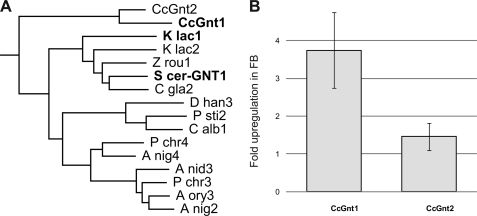FIGURE 3.
Yeast Gnt1 homologues as candidates for the transferase activity in fruiting body. A, phylogenetic analysis of fungal members of the GT8-family found in CaZY data base (27). Shown here, the clade of the yeast Gnt1's (24, 25) and two homologs of C. cinerea. Aspergillus niger: A nig2 (CAK44598.1), A nig3 (CAK43246.1), A nig4 (CAK97109.1); Aspergillus oryzae: A ory3 (BAE63310.1); Candida albicans: C alb1 (AAV04198.1); Candida glabrata: C gla2 (CAG60616.1); C. cinerea: CcGnt1 (CC1G_14119.2), CcGnt2 (CC1G_14164.2) (sequences can be retrieved from the Broad Institute Coprinopsis Database); Debaryomyces hansenii: D han3 (CAG86035.1); Kluyveromyces lactis: K lac1 (AAD25740.1), K lac2 (CAH01694.1); Penicillium chrysogenum: P chr3 (CAP92752.1), P chr4 (CAP98553.1); Pichia stipitis: P sti2 (ABN66322.1); S. cerevisiae: S cer-GNT1 (CAA62175.1); Zygosaccharomyces rouxii: Z rou1 (CAR28822.1). B, relative mRNA levels of CcGnt1 and CcGnt2 in vegetative mycelium and fruiting body. mRNA isolated from mycelium and fruiting body of C. cinerea was used for quantitative real-time PCR (qRT-PCR) analysis of these two developmental states. CcGnt1 is differentially expressed, but CcGnt2 is not. The error bars represent the standard deviation of three experimental replicates.

